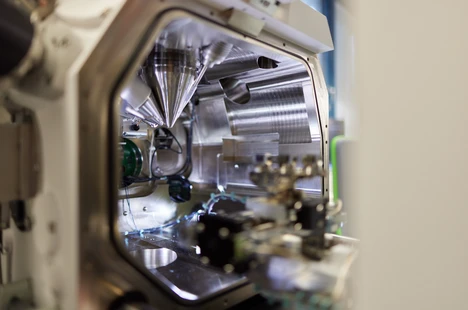Nuclear Fuel Lab
Founded to support the FRM II in its efforts to convert to a lower-enriched fuel, the Nuclear Fuel Laboratory now offers the opportunity to research and develop novel nuclear materials, covering a wide range of activities from sample production and preparation to analytical methods. This comprehensive equipment now also allows a wide range of scientific projects to be tackled independently of the conversion, such as research into ternary uranium alloys or the production of uranium foils for accelerator targets. The laboratory's nuclear regulatory approval allows it to handle uranium and uranium compounds of various enrichment levels.
Sample Production
Sample production includes the manufacture of alloys using an arc melter and the production of thin films and film systems using two PVD systems located in glove boxes under an argon atmosphere. A tube furnace is available for thermal treatments, for example to investigate diffusion processes in a range up to approx. 1000 °C.
Sample Preparation
Prepared samples can be prepared in a variety of ways for subsequent examination: A cutting saw allows sample pieces to be divided, metallographic sample preparation is carried out using hot or cold embedding followed by grinding/polishing, and an ion polisher can be used to further improve the surface quality. A carbon coater is used to prepare non-conductive samples for electron microscopy. A fume hood is also available for handling common chemicals.
Analytics
At the heart of the analysis is a modern focused ion beam electron microscope equipped with detectors for measuring elemental compositions and crystal structures/orientations. In addition, an integrable nanoindenter module allows spatially resolved material properties such as hardness and elastic modulus to be determined at temperatures of up to 800 °C, while simultaneously tracking in-situ thermal diffusion processes. An inverted microscope and a reflected light microscope are available for optical microscopy. For chemical analysis, the laboratory operates an atomic emission spectroscopy device, as well as a UV/VIS and an FTIR spectrometer.
Outside the controlled area, a small laboratory with a fume hood, workbench, and polishing machine is attached to the nuclear section, where inactive samples can be processed. The radiation protection team also operates a gamma spectrometer and a measuring station for evaluating wipe tests for alpha and beta activity.
Device List
- FIB-SEM (Thermo Fisher Scios 2)
- EBSD-detector (EDAX XXX)
- EDX-detector (EDAX XXX)
- Nanoindenter (Femto Tools NMT04)
- ICP-OES (Agilent 5800)
- UV/VIS spectrometer (Analytik Jena Specord 250 Plus)
- FTIR spectrometer (Bruker ALPHA II)
- ion polisher (Hitachi IM4000 Plus)
- sample coater (Leica ACE600)
- surface roughness tester (Mitutoyo SJ-410)
- vacuum impregnation device (Struers CitoVac)
- hot embedding-press (Struers CitoPress-15)
- optical microscopes (Olympus GX53 und BX53M)
- polishing machines (ATM Saphir 520 und Struers Tegramin-25)
- vacuum cabinet (Memmert VO29)
- arc melter (Edmund Bühler MAM-1)
- diamond wire saw (Well 3242-3)
- cut-off saw (Buehler IsoMet 1000)
- tube furnace (Carbolite-Gero TS1 12/60/300)
- gamma spectrometer (Canberra BE3830)
- wipe test station (Berthold LB 770)
